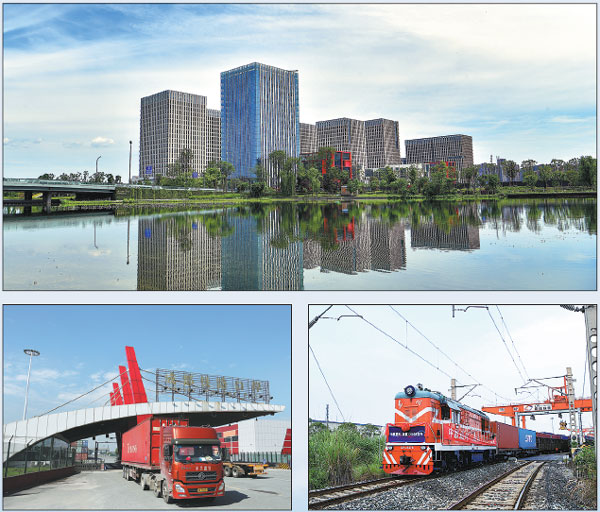Chengdu makes connections to boost trade
To gain more from the Belt and Road Initiative, Chengdu has improved its transportation network by building international air routes and intercontinental railways to transform itself from a hinterland to a frontier of China's opening-up policy.
Chengdu, capital of Sichuan province, served as a major commercial hub thousands of years ago because of its silk, tea and lacquer. Today, it is embracing a greater opportunity offered by the China-proposed Belt and Road Initiative to connect to a wider world.

To gain more from the initiative, Chengdu has improved its transportation network by building international air routes and intercontinental railways to transform itself from a hinterland, about 1,700 kilometers away from the nearest port, to a frontier of the nation's opening-up policy.
The city is now playing an increasingly important role in opening up to the West with the help of the China-Europe Express Railway (Chengdu).
The express railway, a direct freight line launched in 2013, has removed the drawbacks of Chengdu being a landlocked city and transformed it into an important logistics hub and economic exchange center between Europe and western China.
Over the past five years, Chengdu has provided the highest frequency of train service to Europe and sent the most China-EU freight trains, including 1,591 trains in 2018. The express railway now looks at all four points on the compass for expansion, and forms an "across-the-board" opening-up strategy.
It now terminates in Russia in the north and reaches into the heart of Europe and the Central Asian countries in the west. On the east side, it has expanded to Japan, South Korea and the Americas, as well as Hong Kong, Macao and Taiwan, with the help of the Chengdu-Europe Plus strategy and China's longest Yangtze River waterway. On the south side, it has linked with international logistics networks of the Association of Southeast Asian Nations.
To date, the number of the express railway's overseas departure terminals has increased to 24.
More international companies have enjoyed the benefits of the express freight train. TCL, a Chinese home appliance maker, uses the express railway to transport more than 90 percent of the components used in the company's plant in Poland, so far the largest Chinese-funded manufacturing project in the country.
Compared with maritime transport, which takes four to seven weeks, the express train takes only 12 days from Chengdu to Poland.
Other cities in Sichuan have also carried out a wide range of cooperation with Chengdu in regard to the China-Europe Express Railway (Chengdu), through which the province has witnessed nearly 20.4 billion yuan (US$2.98 billion) of imports and exports.
Business prosperity has attracted all kinds of investment and industries from home and abroad to Chengdu. The city's Belt and Road industrial park is home to 84 major trade and logistics projects with a total investment of 50 billion yuan, and also a European industrial town has attracted 12 projects, whose total investment value reached 28 billion yuan.
As the largest aviation hub in western China, the city has made many achievements in the industry. Last year, it opened regular direct passenger flights to Saint Petersburg, Zurich, London, Tel Aviv, Cairo and Copenhagen, and launched regular direct freight flights to Frankfurt and Chicago. By the end of 2018, Chengdu Shuangliu International Airport had operated 114 international air routes, the most in China's central and western areas.
In 2016, Chengdu started the construction of Tianfu International Airport, making it the third city on the Chinese mainland to have two international airports, after Beijing and Shanghai.
Scheduled for operation in 2020, the new airport is expected to handle 90 million passengers and 2 million metric tons of cargo annually.
The city has also improved its aviation port services. Since Jan. 1, it has provided a 24-hour customs clearance service at the Chengdu Aviation Port, and has started a 144-hour visa-free transit to allow visitors from 53 countries to stay for up to six days so long as they present travel documents and tickets to their next destination.
Chengdu's connections to the world are becoming closer. So far, it has established trade and economic relations with 228 countries and regions, and plays host to 17 diplomatic missions. The number of Fortune Global 500 companies in the city has reached 285, more than any other central or western city.
In 2018, Chengdu rose on the level of Beta+ to the 71st place among world cities ranked by the Globalization and World Cities Research Network.

